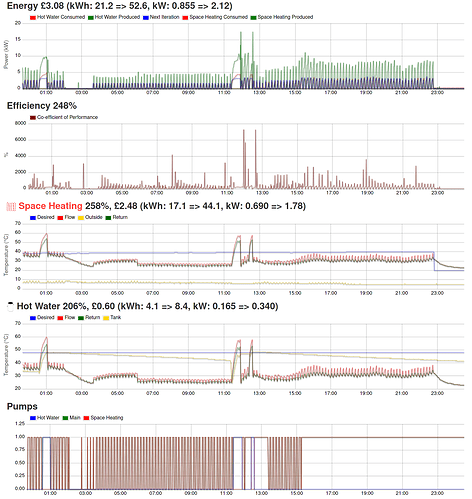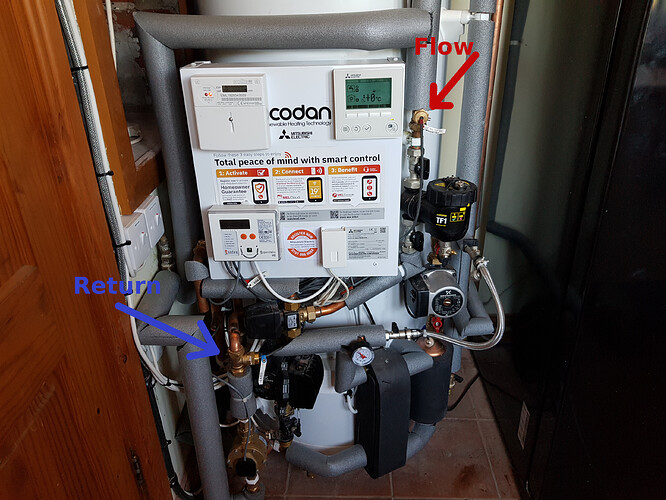As we all know, the most efficient way to run a heat pump is to keep it running all the time.
However, I’d like to propose an alternative. I think there’s a case for turning them off.
Here’s 2019-10-26 - the average temp was 9 Celsius. We can see in the evening the pumps we on all the time and my records show the system was flipping between heating and anti-freeze.
This is a good example of why I split space heating and hot water in my efficiency analysis. The hot water usage is sporadic and dents the CoP in a way that distracts from an experiment like this. We can see space heating has a CoP of 2.58.
Contrast this with 2020-02-10 that also averaged 9 Celsius, but using an algorithm that turns off the heat pump off every so often. We can see it’s still £2.50 to do space heating but the CoP is 3.32. We got an extra 13kWh of space heating for free.
The obvious retort is that the residents will get cold when it’s off. However that’s a matter of perspective. I’ve surveyed them and they seem completely happy - they can’t tell the difference.
The over-sized radiators (cheap Stelrad K2) are acting as a heat store and gently releasing heat during the down time. Notice how we turn it back on when the “return” temperature of the heat pump is about 26 Celsius. At that point the radiators start to feel cold and the residents are sensitive to that. However, whilst they are “warmish” the residents don’t actually know if fresh hot water is being pumped around or not. The “return” of the heat pump monitor (even when not being pumped) is an approximate proxy for the radiator temperature.
My control algorithm uses a few heuristics to decide when to switch off the heat pump, such as “has it been at the desired flow for a few minutes” and “does the heat pump think it’s not worth putting any energy into the next cycle”. For turning back on it just looks at the “return” temperature.
One aspect of this is that the algorithm watches the trend of the cooling and predicts when it’ll come back on. On a number of occasions I’ve though to myself “ooh, it’s getting a bit cool now” only to go and look and see the prediction is for it to start in a couple of minutes or even that it has just started up. I’m the most sensitive person in the house to heat levels which is why my office is set to 23 Celsius - the radiator is 40cm from my chair.
The hysteresis includes the effective outdoor temperature in deciding what represents “cool” and how long it should delay turning on / off. In that way it’s a bit of an extension of the weather compensation.
The heat pump is of course turned on if the temperature gets really cold outside. We have glycol in the circuits though so 0Celsius isn’t a critical temperature for enabling it.




